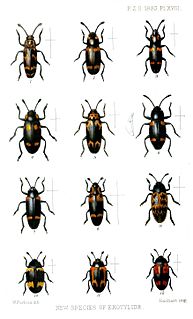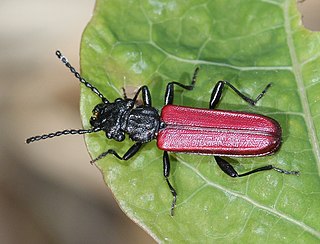
The Cucujidae, "flat bark beetles," are a family of distinctively flat beetles found worldwide under the bark of dead trees. The family has received considerable taxonomic attention in recent years and now consists of 59 species distributed in four genera.

The family Mycteridae is a small group of beetles with no vernacular common name, though recent authors have coined the name palm and flower beetles. The family Mycteridae is distributed worldwide. There are about 30 genera and 160 species. About 20 species are found in Australian, species of three genera are found in North America
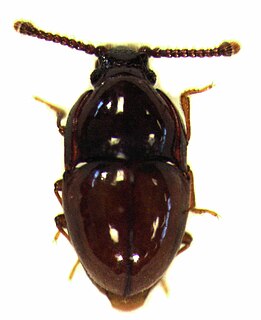
Cryptophagidae is a family of beetles with representatives found in all ecozones. Members of this family are commonly called silken fungus beetles and both adults and larvae appear to feed exclusively on fungi although in a wide variety of habitats and situations, such as rotting wood and shed animal fur and feathers. These beetles vary from about 1 to 11 millimeters long, and usually have an oval body shape with a slight "waist".
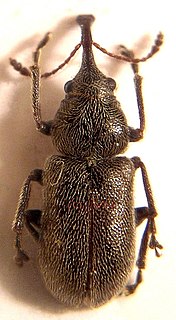
Nemonychidae is a small family of weevils, placed within the primitive weevil group because they have straight rather than elbowed antennae. They are often called pine flower weevils. As in the Anthribidae, the labrum appears as a separate segment to the clypeus, and the maxillary palps are long and projecting. Nemonychidae have all ventrites free, while Anthribidae have ventrites 1-4 connate or partially fused. Nemonychidae lack lateral carinae on the pronotum, while these are usually present, though may be short, in Anthribidae.

Laemophloeidae, "lined flat bark beetles," is a family in the superfamily Cucujoidea characterized by predominantly dorso-ventrally compressed bodies, head and pronotal discs bordered by ridges or grooves, and inverted male genitalia. Size range of adults is 1–5 mm (0.04–0.2 in) in length. Currently, it contains 40 genera and about 450 species, and is represented on all continents except Antarctica; species richness is greatest in the tropics.

Silvanidae, "silvan flat bark beetles", is a family of beetles in the superfamily Cucujoidea, consisting of 58 described genera and about 500 described species. The family is represented on all continents except Antarctica, and is most diverse at both the generic and species levels in the Old World tropics.

The Mycetophagidae or hairy fungus beetles are a family of beetles in the large suborder Polyphaga. The different species are between 1.0 and 6.5 mm in length. The larvae and adults live in decaying leaf litter, fungi, and under bark. Most species feed on fungi. Worldwide, the 18 genera contain around 200 species.
Phlyctaenodini is a tribe of beetles in the subfamily Cerambycinae that includes the following genera and species.
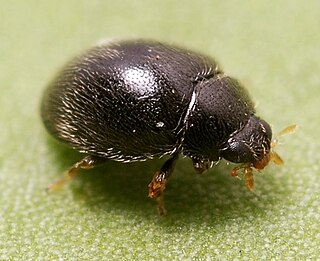
The Scymnini are a tribe of insects within the Coccinellidae family. This group includes many small species that are commonly known as dusky ladybugs.

Kenocoelus is a genus of rove beetles containing a number of species, all endemic to New Zealand. It is part of the Trichonychini tribe, in the Pselaphinae subfamily of Staphylinidae.
Curelius is a genus of silken fungus beetles in the family Cryptophagidae. There are at least two described species in Curelius.
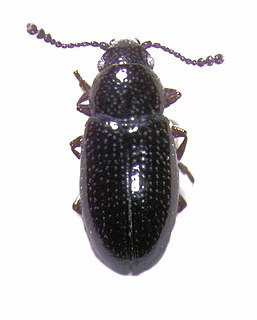
Loberus is a genus of pleasing fungus beetles in the family Erotylidae. There are about 13 described species in Loberus.

Hiletus is a genus of ground beetles. All of the species in the genus live in the tropical forests of Africa.

Atomaria is a genus of silken fungus beetles in the family Cryptophagidae. There are at least 160 described species in Atomaria.
Tyrannomolpus is a genus of leaf beetles in the subfamily Eumolpinae. It is known only from Three Kings Islands, New Zealand. It contains only one species, Tyrannomolpus rex. T. rex is the largest chrysomelid beetle species endemic to New Zealand, measuring between 9.7 and 11.9 mm, and may be an example of island gigantism. It has a dark bronzy-green color with a metallic luster. Tyrannomolpus is closest to the genus Pilacolaspis from the mainland of New Zealand.
Renodesta is a genus of silken fungus beetles in the family Cryptophagidae. There are at least two described species in Renodesta.
Micropsephodes is a genus of beetles in the family Anamorphidae. There are at least two described species in Micropsephodes.
Hadromychus is a genus of handsome fungus beetles in the family Endomychidae. There is at least one described species in Hadromychus, H. chandleri.

Cyclaxyra is a genus of cucujoid beetles in the family Cyclaxyridae. There are two described species in Cyclaxyra, found on the North Island, South Island, and Stewart Island of New Zealand.
